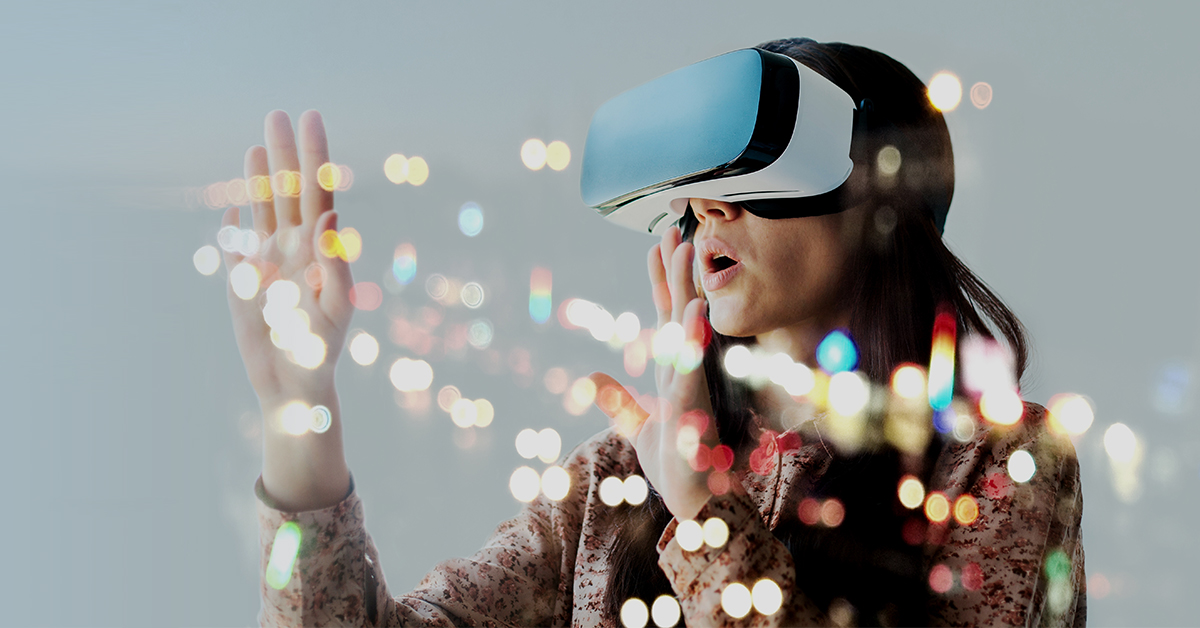By next year, Google will own 80% of the search market. As the world moves forward in technology, search terms will fall in line with voice commands and the way we view the internet is up to the imagination. From wearables – watches, glasses, contacts, and armbands – to holograms, we can only assume the future of how we will use the internet. But one way seems for certain: Virtual Reality.
History
Depending on the definition, one can argue that Virtual Reality has been around as early as 1939. The first wearable device enabled users to view photographs of landscapes.
But as we understand virtual reality today, we can certainly say that this technology has been strong since the late 80’s and early 90’s when virtual reality devices were first introduced to the home through gaming devices.
Virtual Reality Modeling Languages (VRML) programming has been around nearly my entire life. I remember the first time my brother bought me a VRML programming guide, complete with CD ROM tutorials – something I wish I would have taken more seriously as a child.
However, the stigma that virtual reality is synonymous only with gaming is as real today as it was 22 years ago. At the time, I couldn’t imagine why I would want to become a game designer. While I am almost sure I caused myself an early onset of carpal tunnel syndrome at the age of eight from the overuse of our Atari joystick during the release of the new Wing Commander and the original Wolfenstein, I didn’t grow up in a family with a gaming console of any kind. We didn’t have a Nintendo and gaming overall was just not important to me.
Virtual Reality Today
Today, the elements of a virtual reality reach far beyond gaming and affect not just those with Nintendos. Fully-immersive stories, films, and art displays take on the VR/AR world as a new medium for expressing creativity. Simulators move beyond Disney parks and local arcades and are now common in the workplace where companies utilize the technology in training tools for doctors, military personnel, and operators of heavy and specialized machinery. Additionally, real estate agents work to simulate existing environments for potential owners. And architects simulate a world that could be when designing a new building or presenting ideas for refurbishing projects.
The Big Players
Many tech companies are deep into acquiring and developing AR/VR to incorporate into existing products and to develop new products.
This trend to virtual reality has naturally impacted the job market as well. In the past couple years, hiring for virtual reality jobs has increased by 800%. It should be no surprise that Google is aggressively hiring for new VR intelligence positions.
Software
Google announced via their Developers blog that the company is already experimenting with different ways of serving non-intrusive advertising campaigns to Google Cardboard, Daydream View, and Samsung Gear VR headsets.
Google wants to make VR advertising non-disruptive to the user’s immersive experience.
Facebook has also heavily invested in VR. The company purchased Oculus two years ago and has developed a VR-based social media site. We can already assume companies like Amazon, Spotify, Netflix, and Verizon will be moving forward in this new world.
Hardware
Google dominated the VR headset industry with their free-to-use Google Cardboard – owning 69% of all Global VR Headset shipments in 2016. Samsung Gear holds a generous spot in second place at 17% of VR shipment. Oculus Rift, Steam, Sony PS VR, and others make up for 15% of the remaining market.
Today, the VR headset industry is said to be worth $10 billion annually with a predicted reach of a half billion units by 2022.
The Challenge for Marketers
As with Google Glass, the main challenge will be the creation of VR apps and driving engagement with virtual advertising. However, today, marketers should already be considering the challenge of how to alter their search and engagement strategies to cater to the rapidly-growing world of voice commands, wearable technology, and VR/AR.
Consider your own habits over the years and how your use of technology has changed. How often do you open a laptop outside of the office? Are you spending more of your free time utilizing technologies like a Roku, AppleTV, or Chromecast? Do you have a smartwatch, Garmin, or FitBit device? Do you utilize voice command technologies like Siri, Google Home, or Amazon Echo?
As we move into technology that is more interactive, more personalized, and less about our current world of screen time and sharing, the way that we find content and create content will also change. The rising star of virtual technology is a testament to our already-changing world.
Where do you think we are going next? How has your use of technology changed?
Share your story in the comments below.









